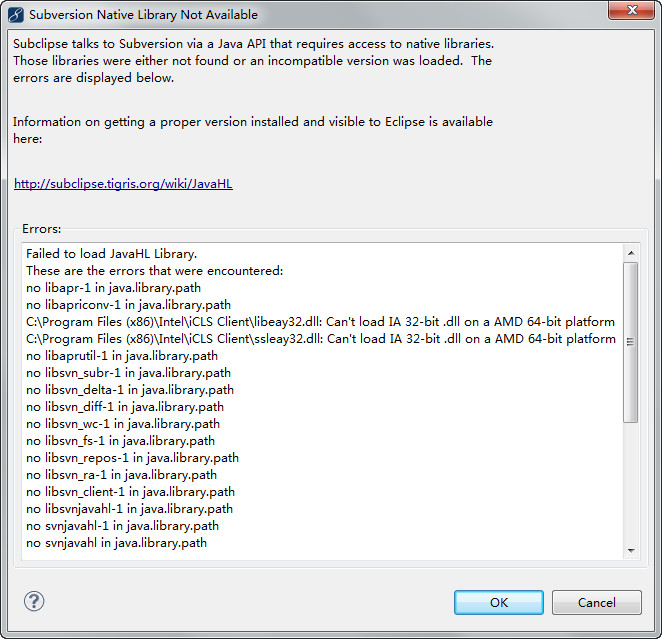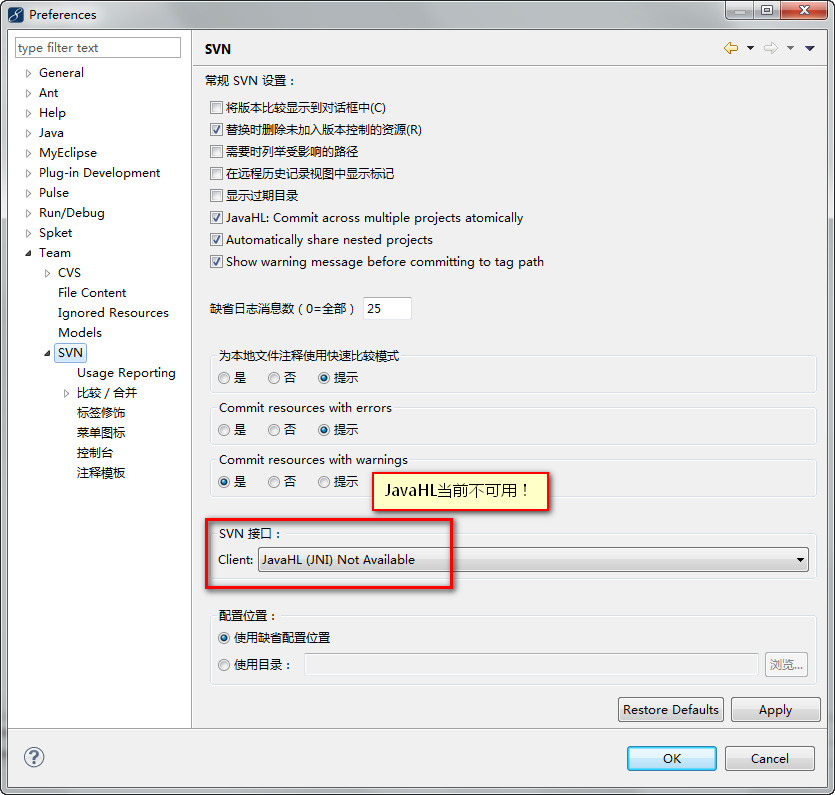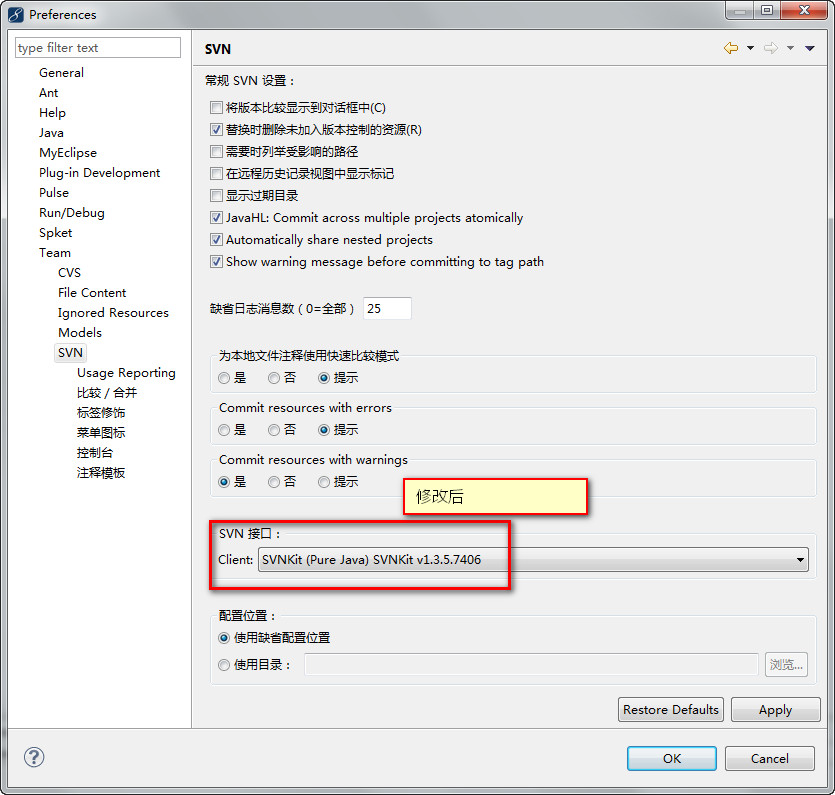posted @ 2016-08-12 10:47 IceWee 閱讀(888) | 評論 (0) | 編輯 收藏
posted @ 2016-01-18 13:43 IceWee 閱讀(433) | 評論 (0) | 編輯 收藏
我們的這次問題原因是程序員在做除法運算時沒有對除數進行非零判斷,導致計算出來的數值非法,插入數據庫失敗,請看代碼:
 public static void main(String[] args) {
public static void main(String[] args) { double a = 10;
double a = 10; double b = 0;
double b = 0; double c = 0;
double c = 0;
 double m = a/c;
double m = a/c; double n = b/c;
double n = b/c;
 System.out.println(m);
System.out.println(m); System.out.println(n);
System.out.println(n); }
}經過計算后,m和n的值分別是多少?沒在實際開發中遇到的可能不知道,或者你有個好習慣不會出現這樣的bug,請看結果:
 Infinity
Infinity NaN
NaN被除數非零,除數為零做除法的結果是字符串“Infinity”,翻譯成中文就是“無限”,你的中學數學老師可能說過;
被除數為零,除數為零做觸發的結果是字符串“NaN”,即不是有效的數字。
就是這個“Infinity”花費了我一小天的時間才定位。下面詳述問題定位的方法。
異常1:ORA-01438: value larger than specified precision allowed for this column
了解點數據庫的打眼一看就知道插入的數值超過了表字段長度,但你知道是哪個表哪個字段嗎?我不知道,于是網上查閱了下,Oracle數據庫服務器在Linux上。
命令行登陸到數據庫所在服務器,進入Oracle的安裝目錄,假設是/opt/oracle/
進入到如下目錄:/opt/oracle/admin/實例名/udump
中間的數據庫實例名根據實際情況修改,udump目錄下會有一堆的.trc文件,這些文件記錄了所有操作當前數據庫出現異常的堆棧信息。為了定位問題,我將該目錄下的所有.trc文件都刪除了(當然,刪除之前把udump目錄整個備份了),再進行一次系統的業務操作,查看一下udump目錄,發現立刻生成一個新 的.trc文件,打開查看(內容片段):
 Oracle Database 10g Enterprise Edition Release 10.2.0.4.0 - 64bit Production
Oracle Database 10g Enterprise Edition Release 10.2.0.4.0 - 64bit Production With the Partitioning, Real Application Clusters, OLAP, Data Mining
With the Partitioning, Real Application Clusters, OLAP, Data Mining and Real Application Testing options
and Real Application Testing options ORACLE_HOME = /u01/app/oracle/product/10.2/db_1
ORACLE_HOME = /u01/app/oracle/product/10.2/db_1 System name: AIX
System name: AIX Node name: gsdj1
Node name: gsdj1 Release: 1
Release: 1 Version: 6
Version: 6 Machine: 00CFD4644C00
Machine: 00CFD4644C00 Instance name: bjwd1
Instance name: bjwd1 Redo thread mounted by this instance: 1
Redo thread mounted by this instance: 1 Oracle process number: 132
Oracle process number: 132 Unix process pid: 48300280, image: oracle@gsdj1
Unix process pid: 48300280, image: oracle@gsdj1
 *** SERVICE NAME:(bjwd) 2014-03-28 16:48:05.683
*** SERVICE NAME:(bjwd) 2014-03-28 16:48:05.683 *** SESSION ID:(2969.43961) 2014-03-28 16:48:05.683
*** SESSION ID:(2969.43961) 2014-03-28 16:48:05.683 *** 2014-03-28 16:48:05.683
*** 2014-03-28 16:48:05.683 ksedmp: internal or fatal error
ksedmp: internal or fatal error ORA-01438: value larger than specified precision allowed for this column
ORA-01438: value larger than specified precision allowed for this column Current SQL statement for this session:
Current SQL statement for this session: insert into CP_TEMP_STOCKTRAN (APPLY_ID, ALIEN, CER_TYPE, CER_NO, TRANS_AM, TRANS_AM_PR, TRANS_TYPE, TRANS_DATE, ENDORSOR, BLIC_TYPE, ALIEN_ID, ENDORSOR_ID, STOCKTRAN_ID) values (:1, :2, :3, :4, :5, :6, :7, :8, :9, :10, :11, :12, :13)
insert into CP_TEMP_STOCKTRAN (APPLY_ID, ALIEN, CER_TYPE, CER_NO, TRANS_AM, TRANS_AM_PR, TRANS_TYPE, TRANS_DATE, ENDORSOR, BLIC_TYPE, ALIEN_ID, ENDORSOR_ID, STOCKTRAN_ID) values (:1, :2, :3, :4, :5, :6, :7, :8, :9, :10, :11, :12, :13)
黃色背景紅色字體的SQL就是罪魁禍首,這僅僅能定位發生問題的數據庫表,字段還得自己排查。異常1讓我定位到了這里,這時想起了異常2。
異常2: Could not synchronize database state with session
之前也搜索過這個異常,多數是由于Number類型的字段導致。冷靜的思考一下,平常我們在做表設計時,會把文字類型的字段設置大一些,Number類型的精度也會根據實際業務進行設計,但往往Number類型的字段最容易出問題:
1、如果將非Number值插入該字段,比如字符串
2、如果插入的數值精度過多,如字段設計Number(10,2),也就是最大支持8為整數和兩位小數,要插入34.121313就會失敗
根據表名定位到hibernate的映射文件以及實體類,再從業務功能入口(一個action方法)搜索,終于定位到一個業務接口做了該實體類的保存代碼,定位到了那個字段,定位到了做除法沒有判斷除數是否為0。
posted @ 2014-03-28 18:54 IceWee 閱讀(883) | 評論 (0) | 編輯 收藏
臨時(重啟丟失)
 ifconfig eth0 192.168.1.xxx netmask 255.255.xxx.0
ifconfig eth0 192.168.1.xxx netmask 255.255.xxx.0永久(重啟有效)
 vi /etc/network/interfaces
vi /etc/network/interfaces # This file describes the network interfaces available on your system
# This file describes the network interfaces available on your system # and how to activate them. For more information, see interfaces(5).
# and how to activate them. For more information, see interfaces(5).
 # The loopback network interface
# The loopback network interface auto lo
auto lo iface lo inet loopback
iface lo inet loopback
 # The primary network interface
# The primary network interface allow-hotplug eth0
allow-hotplug eth0 iface eth0 inet static
iface eth0 inet static address 192.168.1.xxx
address 192.168.1.xxx netmask 255.255.xxx.0
netmask 255.255.xxx.0 network 192.168.1.1
network 192.168.1.1 broadcast 192.168.1.255
broadcast 192.168.1.255 gateway 192.168.1.1
gateway 192.168.1.1 # dns-* options are implemented by the resolvconf package, if installed
# dns-* options are implemented by the resolvconf package, if installed dns-nameservers 202.106.196.115
dns-nameservers 202.106.196.115
由于非法關機導致重啟后無法聯網
 ifconfig eth0 192.168.1.xxx netmask 255.255.xxx.0
ifconfig eth0 192.168.1.xxx netmask 255.255.xxx.0  route add default gw 192.168.1.1
route add default gw 192.168.1.1重啟后配置丟失,所以必須在重啟之前執行:
 apt-get update
apt-get update apt-get install ifupdown
apt-get install ifupdown不能聯網是因為非法關機導致ifup腳本丟失
posted @ 2014-01-24 10:50 IceWee 閱讀(911) | 評論 (0) | 編輯 收藏
備份機器:192.168.1.2
前提條件:
1、兩臺機器的網絡是連通的
2、兩臺機器必須同時安裝了SVN服務器
假設:
源機器上需要同步的庫名為autoSync,訪問地址為:svn://192.168.1.1/autoSync,對其具備讀寫權限的賬戶:sync/sync
備份機器配置:
1、創建與源機器庫名相同的空庫
 # 假設備份機器的SVN根目錄建立在 /home/backup/svn/repository下
# 假設備份機器的SVN根目錄建立在 /home/backup/svn/repository下 svnadmin create /home/backup/svn/repository/autoSync
svnadmin create /home/backup/svn/repository/autoSync2、配置備份機器上的autoSync
分別修改conf下的svnserve.conf、passwd、authz,根據實際情況配置,假設創建了用戶sync/sync,對庫autoSync具備讀寫權限,配置方法略,配置完成后啟動SVN服務
3、創建并修改pre-revprop-change文件
 cd /home/backup/svn/repository/autoSync/hooks
cd /home/backup/svn/repository/autoSync/hooks cp pre-revprop-change.tmpl pre-revprop-change
cp pre-revprop-change.tmpl pre-revprop-change vi pre-revprop-change
vi pre-revprop-change將文件末尾的“exit 1”修改為“exit 0”即可,保存退出
 REPOS="$1"
REPOS="$1" REV="$2"
REV="$2" USER="$3"
USER="$3" PROPNAME="$4"
PROPNAME="$4" ACTION="$5"
ACTION="$5"
 if [ "$ACTION" = "M" -a "$PROPNAME" = "svn:log" ]; then exit 0; fi
if [ "$ACTION" = "M" -a "$PROPNAME" = "svn:log" ]; then exit 0; fi
 echo "Changing revision properties other than svn:log is prohibited" >&2
echo "Changing revision properties other than svn:log is prohibited" >&2 exit 0
exit 0
增加可執行權限
 chmod 755 pre-revprop-change
chmod 755 pre-revprop-change4、初始化
命令:
svnsync init --username 用戶名 --password 密碼 備份機器庫URL 源機器庫URL
說明:
用戶名和密碼是對源機器SVN庫具備讀寫權限的SVN用戶
示例:
 svnsync init --username sync --password sync svn://192.168.1.2/autoSync svn://192.168.1.1/autoSync
svnsync init --username sync --password sync svn://192.168.1.2/autoSync svn://192.168.1.1/autoSync5、首次同步
首次同步即為一次全備份過程,在此期間請停止客戶端段源機器哦一切操作(提交代碼等)
命令:
svnsync sync 備份機器庫URL
示例:
 svnsync sync svn://192.168.1.2/autoSync
svnsync sync svn://192.168.1.2/autoSync源機器配置
6、增量自動同步配置
創建并修改post-commit文件
 # 假設源機器的SVN根目錄建立在 /home/svn/repository下
# 假設源機器的SVN根目錄建立在 /home/svn/repository下 cd /home/svn/repository/autoSync/hooks
cd /home/svn/repository/autoSync/hooks cp post-commit.tmpl post-commit
cp post-commit.tmpl post-commit vi post-commit
vi post-commit在文件末尾追加:svnsync sync --non-interactive 備份機器庫URL --username 用戶名 --password 密碼
說明:
用戶名和密碼是對備份機器SVN庫具備讀寫權限的SVN用戶
示例:
 svnsync sync --non-interactive svn://192.168.1.2/autoSync --username sync --password sync
svnsync sync --non-interactive svn://192.168.1.2/autoSync --username sync --password sync7、術語
配置完成,今后客戶端再向SVN(192.168.1.1)提交文件時,會自動觸發源機器(192.168.1.1)向備份機器(192.168.1.2)提交更新
8、版本庫UUID一致性
首先查看源機器庫的UUID,假設得到的是:fcdcbee9-6be3-4575-8d4a-681ec15ad8e0
 svnlook uuid svn://192.168.1.1/autoSync
svnlook uuid svn://192.168.1.1/autoSync更新備份機器庫的UUID為源機器庫的UUID
 svnadmin setuuid svn://192.168.1.2/autoSync fcdcbee9-6be3-4575-8d4a-681ec15ad8e0
svnadmin setuuid svn://192.168.1.2/autoSync fcdcbee9-6be3-4575-8d4a-681ec15ad8e0posted @ 2014-01-23 11:08 IceWee 閱讀(656) | 評論 (0) | 編輯 收藏
備份源文件
# cp /etc/apt/sources.list /etc/apt/sources.list.bak
編輯源文件
# nano /etc/apt/sources.list
注釋掉本地光盤源這一行,注釋后如:
# deb cdrom:[Debian GNU/Linux 6.0.7 _Squeeze_ - Official amd64 NETINST Binary-1 20130223-18:50]/ squeeze main
取消下面兩行官方源前面的注釋
deb http://security.debian.org/ squeeze/updates main
deb-src http://security.debian.org/ squeeze/updates main
追加163的鏡像源地址
deb http://mirrors.163.com/debian/ squeeze main non-free contrib
deb http://mirrors.163.com/debian/ squeeze-proposed-updates main contrib non-free
deb http://mirrors.163.com/debian-security/ squeeze/updates main contrib non-free
deb-src http://mirrors.163.com/debian/ squeeze main non-free contrib
deb-src http://mirrors.163.com/debian/ squeeze-proposed-updates main contrib non-free
deb-src http://mirrors.163.com/debian-security/ squeeze/updates main contrib non-free
deb http://ftp.sjtu.edu.cn/debian/ squeeze main non-free contrib
deb http://ftp.sjtu.edu.cn/debian/ squeeze-proposed-updates main contrib non-free
deb http://ftp.sjtu.edu.cn/debian-security/ squeeze/updates main contrib non-free
deb-src http://ftp.sjtu.edu.cn/debian/ squeeze main non-free contrib
deb-src http://ftp.sjtu.edu.cn/debian/ squeeze-proposed-updates main contrib non-free
deb-src http://ftp.sjtu.edu.cn/debian-security/ squeeze/updates main contrib non-free
保存修改
# ctrl + o 回車
退出
# ctrl + x
更新源
# apt-get update
更新系統
# apt-get upgrade
安裝SVN服務器
# apt-get install subversion subversion-tools
安裝完成后可以運行命令查看SVN服務器版本信息
# svnserve --version
配置SVN
首先創建版本庫的根目錄,如位置:/home/svn/repository,所有項目都將在該目錄下創建相應子文件夾
# mkdir –p /home/svn/repository
創建項目版本庫test(僅為演示)
# svnadmin create /home/svn/repository/test
修改SVN配置文件
nano /home/svn/repository/test/conf/svnserve.conf
以下為文件內容:
### This file controls the configuration of the svnserve daemon, if you
### use it to allow access to this repository. (If you only allow
### access through http: and/or file: URLs, then this file is
### irrelevant.)
### Visit http://subversion.tigris.org/ for more information.
[general]
### These options control access to the repository for unauthenticated
### and authenticated users. Valid values are "write", "read",
### and "none". The sample settings below are the defaults
# 未授權配置為禁止訪問none,已授權配置為可以讀寫write
anon-access = none
auth-access = write
### The password-db option controls the location of the password
### database file. Unless you specify a path starting with a /,
### the file's location is relative to the directory containing
### this configuration file.
### If SASL is enabled (see below), this file will NOT be used.
### Uncomment the line below to use the default password file.
# 用戶數據庫文件,配置授權用戶,當前使用的文件是和svnserve.conf在相同目錄下的passwd文件,也可以指定其他絕對路徑文件,如:/home/svn/passwd
password-db = passwd
### The authz-db option controls the location of the authorization
### rules for path-based access control. Unless you specify a path
### starting with a /, the file's location is relative to the the
### directory containing this file. If you don't specify an
### authz-db, no path-based access control is done.
### Uncomment the line below to use the default authorization file.
# 授權文件,配置如同用戶配置
authz-db = authz
### This option specifies the authentication realm of the repository.
### If two repositories have the same authentication realm, they should
### have the same password database, and vice versa. The default realm
### is repository's uuid.
# realm = My First Repository
[sasl]
### This option specifies whether you want to use the Cyrus SASL
### library for authentication. Default is false.
### This section will be ignored if svnserve is not built with Cyrus
### SASL support; to check, run 'svnserve --version' and look for a line
### reading 'Cyrus SASL authentication is available.'
# use-sasl = true
### These options specify the desired strength of the security layer
### that you want SASL to provide. 0 means no encryption, 1 means
### integrity-checking only, values larger than 1 are correlated
### to the effective key length for encryption (e.g. 128 means 128-bit
### encryption). The values below are the defaults.
# min-encryption = 0
# max-encryption = 256
保存
# ctrl + o 回車
退出
# ctrl + x
配置用戶
# nano passwd
以下為文件內容:
### This file is an example password file for svnserve.
### Its format is similar to that of svnserve.conf. As shown in the
### example below it contains one section labelled [users].
### The name and password for each user follow, one account per line.
[users]
# harry = harryssecret
# sally = sallyssecret
IceWee = IceWee
增加用戶IceWee,密碼也為IceWee,=號兩側需要有空格,保存(ctrl + o 回車)退出(ctrl + x)
配置訪問權限
# nano authz
以下為文件內容:
### This file is an example authorization file for svnserve.
### Its format is identical to that of mod_authz_svn authorization
### files.
### As shown below each section defines authorizations for the path and
### (optional) repository specified by the section name.
### The authorizations follow. An authorization line can refer to:
### - a single user,
### - a group of users defined in a special [groups] section,
### - an alias defined in a special [aliases] section,
### - all authenticated users, using the '$authenticated' token,
### - only anonymous users, using the '$anonymous' token,
### - anyone, using the '*' wildcard.
###
### A match can be inverted by prefixing the rule with '~'. Rules can
### grant read ('r') access, read-write ('rw') access, or no access
### ('').
[aliases]
# joe = /C=XZ/ST=Dessert/L=Snake City/O=Snake Oil, Ltd./OU=Research Institute/CN=Joe Average
[groups]
# harry_and_sally = harry,sally
# harry_sally_and_joe = harry,sally,&joe
developers = IceWee
# [/foo/bar]
# harry = rw
# &joe = r
# * =
# [repository:/baz/fuz]
# @harry_and_sally = rw
# * = r
[/]
* = r
IceWee = rw
@developers = rw
[/tags]
IceWee = rw
默認所有用戶可讀取根,IceWee可以讀寫根。可以分別對子目錄進行授權,如上的tags目錄,IceWee具有讀寫權限,以及IceWee所在的組developers也具備讀寫權限。
啟動SVN服務器
# svnserve -d -r /home/svn/repository
-d含義為后臺運行(daemon),-r指定的根目錄,如訪問test應該使用這樣的地址 svn://hostname:port/test
停止SVN服務
# killall svnserve
備份還原命令,與oracle的備份有些類似
導出
# svnadmin dump /home/svn/repository/test > /home/bak/test.dump
導入
# svnadmin load /home/svn/repository/demo < /home/bak/demo.dump
導入前提:
必須先創建要導入版本庫目錄,如上的demo,則需要做以下操作
# svnadmin create /home/svn/respository/demo
修改svnserve.conf、passwd、authz等文件,前面已介紹
posted @ 2014-01-17 15:48 IceWee 閱讀(1232) | 評論 (0) | 編輯 收藏
2013年12月10日
---------------------------
冒泡排序
 void bubble(int[] array) {
void bubble(int[] array) { boolean swaped = true;
boolean swaped = true; for (int t = 1; t < array.length && swaped; t++) {
for (int t = 1; t < array.length && swaped; t++) { swaped = false;
swaped = false; for (int i = 0; i < array.length - t; i++) {
for (int i = 0; i < array.length - t; i++) { if (array[i] > array[i + 1]) {
if (array[i] > array[i + 1]) { int temp = array[i];
int temp = array[i]; array[i] = array[i + 1];
array[i] = array[i + 1]; array[i + 1] = temp;
array[i + 1] = temp; swaped = true;
swaped = true; }
} }
} }
} }
}2013年11月26日
---------------------------
1、String的split方法
平常總是這樣用,String str = "a,b,c,d,e"; String[] arr = str.split(",");
其實還可以這樣用,String lan = "Java;C#?C++:C"; String si = lan.split("[;?:]"); 返回的是字符串數組{"Java", "C#", "C++", "C"}
2013年11月21日
---------------------------
1、Java對象池知多少?
示例:String s1 = "abc"; String s2 = "abc"; s1 == s2 返回ture還是false?只要不是new出來的都先從對象池中讀取,因此結果為true,兩個變量指向的是同一塊內存空間地址。
Java除了String類使用了對象池以外,還有5個基本類型的封裝類:Byte、Short、Integer、Long和Character,例如:Integer inA = 20; Integer inB = 20; 那么 inA == inB 的結果為true,其他類與此相同,不做示例。
特別注意:
(1)浮點型的兩個封裝類Float和Double并沒有參與對象池;
(2)整形封裝類(Byte、Short、Integer和Long)只有數值小于或等于127時才使用對象池,例如:Integer x = 128; Integer y = 128; x == y的結果為false。
2、Java變量命名規范
A. String #name = "Joe";
B. int $age = 30;
C. Double _height = 174.4;
D. float ~temp = 37.6;
以上A到D,哪個無法通過編譯?答案是A和D,因為Java變量名只允許字母、下劃線(_)、美元符($)開頭,那么 int _ = 30; String $$ = "I DO";可以嗎?答案是完全可以,但很少有人這樣定義變量名,雖然沒有違法命名規范,但最后我估計程序員自己都會被自己繞暈。
3、0和1能標識布爾值嗎?
int flag = 0;
if (flag) {
System.out.print("error");
}
error會打印嗎?不會,因為根本就不會編譯通過,編譯器會提示flag是int類型而不是boolean類型,如果你會有這種想法可能之前學過C,C總的0和1可以標識布爾的。
4、靜態導入
例:
ClassA.java
 package bing.test.sub1;
package bing.test.sub1;
 public class ClassA {
public class ClassA { public static final int MAX_INT = Integer.MAX_VALUE;
public static final int MAX_INT = Integer.MAX_VALUE; }
}ClassB.java
 package bing.test.sub2;
package bing.test.sub2;
 import static bing.test.sub1.ClassA.MAX_INT;
import static bing.test.sub1.ClassA.MAX_INT;
 public class ClassB {
public class ClassB { public static void main(String[] args) {
public static void main(String[] args) { System.out.println(MAX_INT);
System.out.println(MAX_INT); }
} }
}輸出:2147483647。不僅僅可以靜態導入其他類的靜態屬性還可以導入靜態方法,這些特性在實際開發中很少見。
posted @ 2013-11-21 12:49 IceWee 閱讀(470) | 評論 (0) | 編輯 收藏
原因是因為默認緩沖區大小是1024,也就是1K,當然慢了,在調用上傳API之前重新修改以下默認設置即可,如將緩沖區改為10M,API:
posted @ 2013-09-13 16:32 IceWee 閱讀(6713) | 評論 (0) | 編輯 收藏
 --查詢被鎖住的數據庫對象
--查詢被鎖住的數據庫對象 select object_name, machine, s.sid, s.serial#
select object_name, machine, s.sid, s.serial# from v$locked_object l, dba_objects o, v$session s
from v$locked_object l, dba_objects o, v$session s where l.object_id = o.object_id
where l.object_id = o.object_id and l.session_id = s.sid;
and l.session_id = s.sid;第二步,殺死數據庫會話
 --殺死數據庫會話
--殺死數據庫會話 alter system kill session '207,707'; -- 207為SID, 707為SERIAL#
alter system kill session '207,707'; -- 207為SID, 707為SERIAL#第三步,如果第二步無法殺死會話,報ORA-00031,那么只能殺死UNIX/LINUX系統進程了
 --查詢當前操作的系統進程ID
--查詢當前操作的系統進程ID select spid, osuser, s.program
select spid, osuser, s.program from v$session s, v$process p
from v$session s, v$process p where s.paddr = p.addr
where s.paddr = p.addr and s.sid = 207; -- 207為SID
and s.sid = 207; -- 207為SID第四步,根據查詢到的系統PID,殺掉進程
 kill -9 24664 // 24664為UNIX/LINUX系統進程ID
kill -9 24664 // 24664為UNIX/LINUX系統進程IDposted @ 2013-08-23 10:20 IceWee 閱讀(536) | 評論 (0) | 編輯 收藏
posted @ 2013-07-27 11:53 IceWee 閱讀(1449) | 評論 (0) | 編輯 收藏
 /**
/** * IceWee 2013.07.19
* IceWee 2013.07.19 * 獲取本地IP列表(針對多網卡情況)
* 獲取本地IP列表(針對多網卡情況) *
* * @return
* @return */
*/ public static List<String> getLocalIPList() {
public static List<String> getLocalIPList() { List<String> ipList = new ArrayList<String>();
List<String> ipList = new ArrayList<String>(); try {
try { Enumeration<NetworkInterface> networkInterfaces = NetworkInterface.getNetworkInterfaces();
Enumeration<NetworkInterface> networkInterfaces = NetworkInterface.getNetworkInterfaces(); NetworkInterface networkInterface;
NetworkInterface networkInterface; Enumeration<InetAddress> inetAddresses;
Enumeration<InetAddress> inetAddresses; InetAddress inetAddress;
InetAddress inetAddress; String ip;
String ip; while (networkInterfaces.hasMoreElements()) {
while (networkInterfaces.hasMoreElements()) { networkInterface = networkInterfaces.nextElement();
networkInterface = networkInterfaces.nextElement(); inetAddresses = networkInterface.getInetAddresses();
inetAddresses = networkInterface.getInetAddresses(); while (inetAddresses.hasMoreElements()) {
while (inetAddresses.hasMoreElements()) { inetAddress = inetAddresses.nextElement();
inetAddress = inetAddresses.nextElement(); if (inetAddress != null && inetAddress instanceof Inet4Address) { // IPV4
if (inetAddress != null && inetAddress instanceof Inet4Address) { // IPV4 ip = inetAddress.getHostAddress();
ip = inetAddress.getHostAddress(); ipList.add(ip);
ipList.add(ip); }
} }
} }
} } catch (SocketException e) {
} catch (SocketException e) { e.printStackTrace();
e.printStackTrace(); }
} return ipList;
return ipList; }
}posted @ 2013-07-19 11:10 IceWee 閱讀(4371) | 評論 (1) | 編輯 收藏
1.工作空間的編碼(這樣以后新建的文件也是新設置的編碼格式)
eclipse->window->preferences->General->workspaceTypes->Other->UTF-8->OK
2.工程的編碼
Project->Properties->General->Resource->Other->UTF-8->OK
3.某類文件的編碼
eclipse->window->preferences->General->Content Types->右側找到需要修改的文件的類型(如JAVA,JSP等)->在下面的Default encoding,輸入框中輸入UTF-8->點擊Update->OK
4、單個文件的編碼
在包資源管理器視圖,右鍵點擊文件->屬性,改變文本文件編碼格式為UTF-8
posted @ 2013-06-17 14:15 IceWee 閱讀(825) | 評論 (0) | 編輯 收藏
稍后上圖,服務器估計掛了!!
解決方法:
Window-Preferences-Team-SVN,在SVN接口的下拉框可以看到,默認選擇的是JavaHL(JNI) Not Available,手動更改為SVNKit(Pure Java) SVNKit v1.3.5.7406,OK,enjoy it!
錯誤提示框:

修改前:

修改后:

posted @ 2013-03-18 15:13 IceWee 閱讀(78948) | 評論 (6) | 編輯 收藏
一、Redhat上VNC Server配置
本文以當前Linux系統未安裝VNC服務器為基本,如果已安裝請跳過第1節!
前提:
1.連接到互聯網,將使用yum在線安裝VNC服務器
2. 確認 SSH 在運行
1.安裝 TigerVNC Server
 # yum search tigervnc-server
# yum search tigervnc-server
返回大概如下內容:
 tigervnc-server.x86_64 : A TigerVNC Server
tigervnc-server.x86_64 : A TigerVNC Server tigervnc-server-applet.noarch : Java TigerVNC Viewer applet for TigerVNC Server
tigervnc-server-applet.noarch : Java TigerVNC Viewer applet for TigerVNC Server tigervnc-server-module.x86._64 : TigerVNC Mode to Xorg
tigervnc-server-module.x86._64 : TigerVNC Mode to Xorg ...
...
第一行即是我們要安裝的VNS服務器,第二行是客戶端,執行
 # yum install tigervnc-server.x86_64
# yum install tigervnc-server.x86_64
回車后會有一次安裝確認,輸入y后回車即可安裝,安裝完畢后返回到命令行輸入光標,執行
 # vncserver
# vncserver
會提示輸入驗證密碼,至少6位,該密碼是客戶端連接時用到的。
2.配置圖形界面
修改配置文件,激活圖形界面,執行命令:
 # vi /root/.vnc/xstartup
# vi /root/.vnc/xstartup
注釋掉這行
 #twm & // 注釋該行
#twm & // 注釋該行
末尾增加一行
 gnome-session & // 增加該行
gnome-session & // 增加該行
保存退出
3.啟動VNC服務
執行命令
 # /etc/init.d/vncserver start
# /etc/init.d/vncserver start或
 # service vncserver start
# service vncserver start
啟動后提示:
 Starting VNC server: no displays configured [FAILED]
Starting VNC server: no displays configured [FAILED]
解決方法:
執行命令
 # vim /etc/sysconfig/vncservers
# vim /etc/sysconfig/vncservers
修改最后兩行如:
 VNCSERVERS="1:root"
VNCSERVERS="1:root" VNCSERVERARGS[1]="-geometry 1024x768"
VNCSERVERARGS[1]="-geometry 1024x768"
說明:
第一行為服務配置,當前只配置了一個VNC服務,使用用戶root啟動,如果還需要使用其他用戶登陸,可以修改VNCSERVERS的值如:“1:root 2:tiger”(tiger為系統另一存在用戶)。第二行可以注釋,是配置窗口分辨率的,需要去掉后面的-localhost
VNC Server隨系統自動啟動
執行命令
 # sudo chkconfig --level 345 vncserver on
# sudo chkconfig --level 345 vncserver on
4.停止VNC服務
執行命令
 # /etc/init.d/vncserver stop
# /etc/init.d/vncserver stop或
 # service vncserver stop
# service vncserver stop
二、Windows借助VNC Viewer訪問Linux
首先安裝RealVNC,從互聯網下載獲得
開始 - Run VNC Viewer,輸入IP地址,后面的:1代表使用root用戶登陸,在RH上配置的1:root,如果想使用其他用戶登陸則調整冒號后的數字即可,密碼就是先前配置的。
解決連接不上問題的方法
執行命令,查看VNC監聽的端口是什么,在防火墻中開放端口即可
 # netstat -ntupl|grep vnc
# netstat -ntupl|grep vnc
返回列表如:
 1. tcp 0 0 0.0.0.0:5901 0.0.0.0:* LISTEN 4411/Xvnc
1. tcp 0 0 0.0.0.0:5901 0.0.0.0:* LISTEN 4411/Xvnc  2. tcp 0 0 0.0.0.0:6001 0.0.0.0:* LISTEN 4411/Xvnc
2. tcp 0 0 0.0.0.0:6001 0.0.0.0:* LISTEN 4411/Xvnc  3. tcp 0 0 :::6001 :::* LISTEN 4411/Xvnc
3. tcp 0 0 :::6001 :::* LISTEN 4411/Xvnc
修改防火墻配置文件,開放5901端口即可
 # vi /etc/sysconfig/iptables
# vi /etc/sysconfig/iptables
可以復制22端口一行,黏貼修改即可,重新啟動防火墻服務
 # service iptables restart
# service iptables restart
posted @ 2013-02-22 17:46 IceWee 閱讀(21974) | 評論 (2) | 編輯 收藏
基本信息
操作系統:CentOS Release 6.3 (Final)
內核版本:Kernel Linux 2.6.32-279.el6.x86_64
JDK版本:Oracle ®Java SE Development Kit 7u15 (1.7.0_15-b03)
JBoss版本:JBoss Application Server 7.1.1
安裝包: jdk-7u15-linux-x64.rpm、jboss-as-7.1.1.Final.zip
安裝準備
上傳安裝文件
將JDK和JBoss安裝文件(先解壓成目錄)上傳到服務器,目錄隨意,如:/home/下
開始安裝
JDK安裝
使用root登陸系統,打開命令行窗口,先為安裝文件授權
 # chmod 755 jdk-7u15-linux-x64.rpm
# chmod 755 jdk-7u15-linux-x64.rpm
執行安裝
 # rpm -ivh jdk-7u15-linux-x64.rpm
# rpm -ivh jdk-7u15-linux-x64.rpm
自動安裝到目錄 /usr/java 下
JDK配置
Root登陸執行
 # vi /etc/profile
# vi /etc/profile
增加下面內容
 JAVA_HOME=/usr/java/jdk1.7.0_15
JAVA_HOME=/usr/java/jdk1.7.0_15 CLASSPATH=.:$JAVA_HOME/lib:$JAVA_HOME/jre/lib
CLASSPATH=.:$JAVA_HOME/lib:$JAVA_HOME/jre/lib PATH=$JAVA_HOME/bin:$PATH
PATH=$JAVA_HOME/bin:$PATH
保存退出,執行如下命令立即生效以上環境配置
 # source /etc/profile
# source /etc/profile
JDK版本檢測,執行:
 # java – version
# java – version返回JDK版本信息
JBoss安裝
JBoss為綠色版本,不需要安裝,解壓即可使用,和Tomcat一樣,下面將JBoss目錄移動到一個相對規范的位置,Root登陸執行
 # mv /home/jboss-as-7.1.1.Final /usr/jboss-as-7.1.1.Final
# mv /home/jboss-as-7.1.1.Final /usr/jboss-as-7.1.1.Final
OK,安裝完畢,配置一下環境變量,執行
 # vi /etc/profile
# vi /etc/profile
增加下面內容
 JBOSS_HOME=/usr/jboss-as-7.1.1.Final
JBOSS_HOME=/usr/jboss-as-7.1.1.Final
啟動服務
 # /usr/jboss-as-7.1.1.Final/bin/standalone.sh
# /usr/jboss-as-7.1.1.Final/bin/standalone.sh訪問,在瀏覽器地址欄中輸入:http://127.0.0.1:8080,出現歡迎界面,證明啟動成功!
停止服務
可以在啟動終端窗口按鍵 CTRL + C,即可完全停止JBoss服務
局域網訪問
http://xxx.xx.xx.xxx:8080是不能訪問的,如果想讓局域網內的其他機器訪問必須要修改JBoss配置,方法如下:
編輯jboss-as-7.1.1.Final\standalone\configuration\standalone.xml,找到
 <interface name="public">
<interface name="public"> <inet-address value="${jboss.bind.address:127.0.0.1}"/>
<inet-address value="${jboss.bind.address:127.0.0.1}"/> </interface>
</interface>
將127.0.0.1修改為JBoss所在機器的IP地址即可,但是依舊無法訪問,是因為Linux防火墻沒有開放8080端口,執行:
 # vi /etc/sysconfig/iptables
# vi /etc/sysconfig/iptables
發現有一行
-A INPUT -m state --state NEW -m tcp -p tcp --dport 22 -j ACCEPT
復制它把22改成8080追加該行后面保存退出!
創建管理員用戶
 # ./add-user.sh
# ./add-user.sh
 What type of user do you wish to add?
What type of user do you wish to add? a) Management User (mgmt-users.properties)
a) Management User (mgmt-users.properties) b) Application User (application-users.properties)
b) Application User (application-users.properties) (a):
(a):回車
 Enter the details of the new user to add.
Enter the details of the new user to add. Realm (ManagementRealm) : //回車,默認
Realm (ManagementRealm) : //回車,默認 Username : // 管理員用戶名,如:admin
Username : // 管理員用戶名,如:admin Password : // 管理員密碼,如:jboss
Password : // 管理員密碼,如:jboss Re-enter Password : // 重復密碼
Re-enter Password : // 重復密碼
管理員控制臺訪問
http://127.0.0.1:9990/console
如果也想在其他局域網機器上訪問管理員控制臺,防火墻需要開放端口9990,修改standalone.xml
 <interface name="management">
<interface name="management"> <inet-address value="${jboss.bind.address.management:127.0.0.1}"/>
<inet-address value="${jboss.bind.address.management:127.0.0.1}"/> </interface>
</interface>
同樣將127.0.0.1修改為JBoss所在機器的IP地址
posted @ 2013-02-22 17:12 IceWee 閱讀(5053) | 評論 (0) | 編輯 收藏







